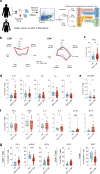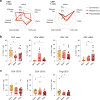Altered CD4 T cell response in oligometatastic non-small cell lung cancer brain metastasis
- PMID: 40346687
- PMCID: PMC12063345
- DOI: 10.1186/s40478-025-02011-1
Altered CD4 T cell response in oligometatastic non-small cell lung cancer brain metastasis
Abstract
Lung cancer is the leading cause of cancer mortality globally, with brain metastasis (BM) in 40% of advanced non-small-cell lung cancer (NSCLC) cases. In 15% of these cases, the brain is the sole affected organ (oligometastasis), which correlates with a better prognosis compared to widespread disease. It remains unclear if brain-only metastasis without systemic spread is due to the immune system's ability to control systemic tumor progression. We studied the immune cell compositions in NSCLC patients with BM, identifying novel patterns associated with BM, and specifcally with either oligo- or polymetastatic spread. Multi-parametric immune phenotyping of peripheral blood primarily showed alterations in the CD4+ T cell compartment, with increased CD4+ TH17 cells, and higher IL-17 levels in NSCLC BM patients compared to healthy individuals. Furthermore, CD4+ T cells in BM patients exhibited lower CD73 expression and reduced effector memory differentiation. There was also decreased intratumoral infiltration and a distinct CD4+ T cell profile in oligo-synchronous BM, both in the tumor microenvironment and peripheral blood, compared to polymetastatic BM patients. Additionally, CD73 was significantly upregulated in CD4+ and T regulatory cells of oligo-synchronous (BM simulantously with primary-tumor diagnosis) BM. These findings suggest that CD4+ T cells play a crucial role in the biology of NSCLC BM and potentially contribute to differences in metastatic patterns, as oligo-synchronous BM shows a more significant alteration in the CD4+ T cell immune profile, both locally at the tumor site and systemically.
Keywords: Brain metastasis; CD4; Immunophenotyping; NSCLC; T cells.
© 2025. The Author(s).
Conflict of interest statement
Declarations. Ethics approval and consent to participate: This study was approved by the local ethics council of the Hamburg chamber for physicians under numbers Nr. PV5392 & Nr. PV4904 and was performed in accordance with the Helsinki Declaration of 1975. Consent for publication: Not applicable. Competing interests: The authors declare no competing interests.
Figures




References
-
- Sung H, Ferlay J, Siegel RL et al (2021) Global Cancer statistics 2020: GLOBOCAN estimates of incidence and mortality worldwide for 36 cancers in 185 countries. CA Cancer J Clin 71(3):209–249 - PubMed
-
- Weichselbaum RR, Hellman S (2011) Oligometastases revisited. Nat Rev Clin Oncol 8(6):378–382 - PubMed
Publication types
MeSH terms
LinkOut - more resources
Full Text Sources
Medical
Research Materials

